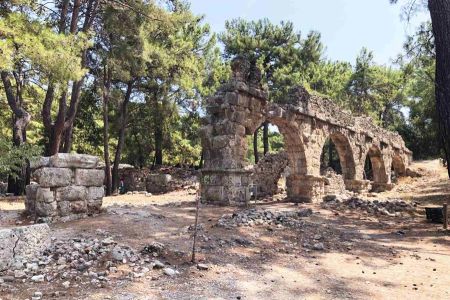Phaselis Antalya – port and trading centre in Lycia
- Written by Portal Editor
Phaselis was one of the most important trading centres in the Mediterranean for several centuries in ancient times. Goods such as Lycian cedar wood and rose oil were shipped from here to Egypt and the Middle East.
It has been archaeologically researched since 1811 and, like Olympos, is located in the Olimpos Beydağları National Park, far away from the nearest modern town.
Phaselis as a trading city near Attaleia, today, Antalya
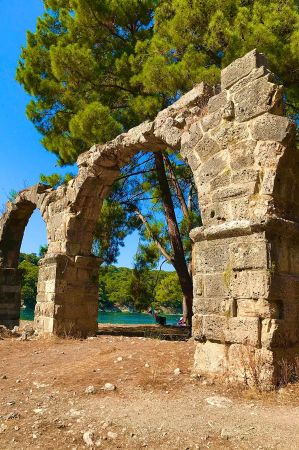 As a trading city with three ports in the immediate vicinity of the Persian sphere of influence in Asia Minor, it was of outstanding importance until the founding of Attaleia (Antalya) around 150 BC and was economically exceptionally prosperous. The boulevard, agora’s, theatre, thermal baths, harbour walls, aqueduct and Byzantine ruins have been preserved.
As a trading city with three ports in the immediate vicinity of the Persian sphere of influence in Asia Minor, it was of outstanding importance until the founding of Attaleia (Antalya) around 150 BC and was economically exceptionally prosperous. The boulevard, agora’s, theatre, thermal baths, harbour walls, aqueduct and Byzantine ruins have been preserved.
Membership of the Athenian League in the 5th century BC The 5th century AD brought Phaselis economic prosperity - and at the same time a bad reputation as a quarrelsome and greedy merchant town.
In the 5th century, Phaselis began to mint coins with the prow of a ship on one side. These coins were still in use until the third century AD. The city willingly opened its gates when Alexander the Great came to Anatolia. Strabo describes Alexander's "adventures" in the city as follows:
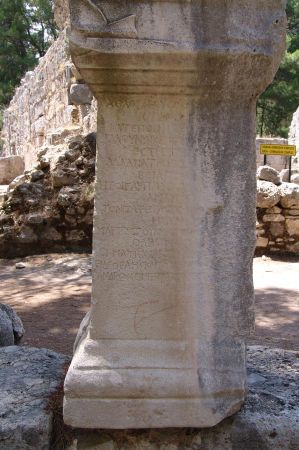 ".....afterward he came to Phaselis, which is known as a city with three important ports and the river. The Solyma Mountains rise there, while Termessos was founded on the long passages in the middle of the mountains. There is a long stretch that leads to Milyas. Alexander destroyed Milyas because he wanted to pass through unhindered. However, there are three other passages near the mountains around Phaselis and these passages were formed by Alexander's army.....”
".....afterward he came to Phaselis, which is known as a city with three important ports and the river. The Solyma Mountains rise there, while Termessos was founded on the long passages in the middle of the mountains. There is a long stretch that leads to Milyas. Alexander destroyed Milyas because he wanted to pass through unhindered. However, there are three other passages near the mountains around Phaselis and these passages were formed by Alexander's army.....”
Pirates settled in Phaselis and in 77 BC it was destroyed. Brutus, who came to Phaselis in 42 BC, "removed" the pirates and incorporated the city into the Roman Empire. After this incorporation, the city flourished. The conqueror Hadrian came to Phaselis in 129 AD. The people living there glorified the conqueror with sculptures they had created themselves. Moreover, they built a monumental gate on the spot that the conqueror's ship used as a berth.
Heyday as a Byzantine naval base
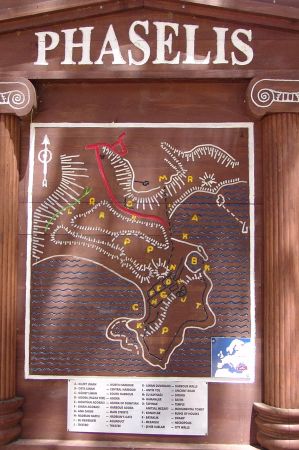 After a brief heyday as a Byzantine naval base, Phaselis fell to the Seljuks in 1158 and was then forgotten. Description of Phaselis from Sir C. Fellows in his "Excursion in Asia Minor" (page 221):
After a brief heyday as a Byzantine naval base, Phaselis fell to the Seljuks in 1158 and was then forgotten. Description of Phaselis from Sir C. Fellows in his "Excursion in Asia Minor" (page 221):
“In five hours, before 8 a.m., we were at Tekrova, ancient Phaselis. We landed and immediately I saw the ruins of the old port. As much as I appreciated the ruins of the city inside, I admired both the design and dimensions, the workmanship of the ancient inhabitants, the traces of the ports and the maritime knowledge associated with them. The port and town of Phaselis are extremely skilfully built and very interesting, though small; the theatre, the stadium and the temples can still be traced and the many tombs on the hills show how long the city must have existed.”
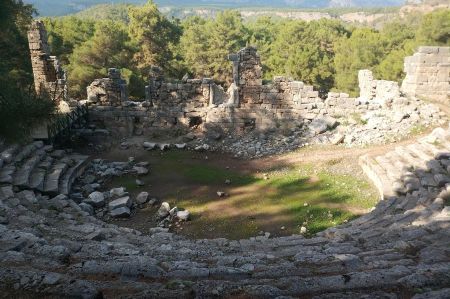 According to sources, the city of Phaselis/Phaeselis near Kemer was founded around 690 BC as a Rhodian colony.
According to sources, the city of Phaselis/Phaeselis near Kemer was founded around 690 BC as a Rhodian colony.
In the 6th century, it was represented in the trading post of Naukratis in Egypt, with Rhodes, Cnidus and Halicarnassus, among others. From around 550 BC, it belonged to the Persian Empire for a long time - a position that was culturally and economically important for many Greek cities in Asia Minor.
Politically, however, this was used in Athens as a pretext to disguise the Athenian activities of the Athenian League as an anti-Persian fighting alliance. Thus, in 469 BC, Phaselis was "forcibly liberated" and forced into the League - as a flourishing trading city with high tributes in a strategically important location, a significant gain for Athens.
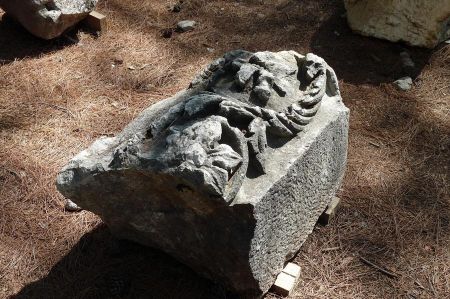 After 411 BC, Phaselis again fell under Persian rule, and surrendered to Alexander the Great in 333 BC. According to Pausanias, Achilles' spear was found in the Temple of Athena, the city's main sanctuary. This may also have been a reason for Alexander to stay here, as he considered himself the "new Achilles". Plutarch reports that Alexander, intoxicated by wine, decorated the monument of Theodectes with wreaths on his way home from a drinking party with his companions.
After 411 BC, Phaselis again fell under Persian rule, and surrendered to Alexander the Great in 333 BC. According to Pausanias, Achilles' spear was found in the Temple of Athena, the city's main sanctuary. This may also have been a reason for Alexander to stay here, as he considered himself the "new Achilles". Plutarch reports that Alexander, intoxicated by wine, decorated the monument of Theodectes with wreaths on his way home from a drinking party with his companions.
During the Diadochi Wars, initially Ptolemaic (until 197 BC), then Seleucid (until 187 BC), it was incorporated into the Lycian League under Roman rule until around 100 BC, although it belonged to Pamphylia.
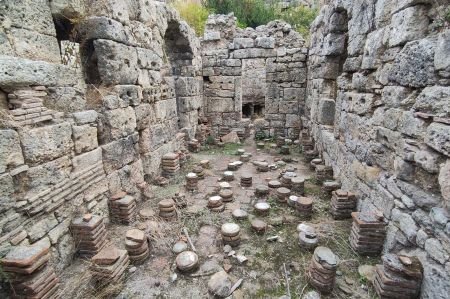 The strong competitor Attaleia (Antalya) as a port and trading city brought Phaselis its first decline, which caused it to become a hideout for Cilician pirates at the beginning of the 1st century BC, together with Olympos.
The strong competitor Attaleia (Antalya) as a port and trading city brought Phaselis its first decline, which caused it to become a hideout for Cilician pirates at the beginning of the 1st century BC, together with Olympos.
Under Domitian, Trajan and Hadrian, the city, which had been destroyed in the pirate wars, was rebuilt in a representative manner at the end of the 1st century AD and experienced a second boom. Most of the ruins that have survived today date from this period. However, Phaselis never recovered from the later raids by pirates and Arabs in the middle of the 7th century, even though it temporarily rose economically again as a Byzantine naval base in the 8th century. From the 10th century onwards, it served only as a quarry for Antalya, which needed material for its fortifications.
Natural safe harbour
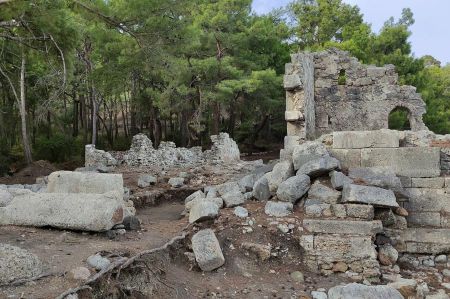 Phaselis lies on a small peninsula at the foot of the Taurus Mountains. The little hinterland is largely swampy. Phaselis owes its unique importance as a city with three largely natural harbours to its special shape. The ancient breakwaters can still be seen in the large northern harbour. The well-preserved imperial aqueduct also leads along the city for around 400 meters.
Phaselis lies on a small peninsula at the foot of the Taurus Mountains. The little hinterland is largely swampy. Phaselis owes its unique importance as a city with three largely natural harbours to its special shape. The ancient breakwaters can still be seen in the large northern harbour. The well-preserved imperial aqueduct also leads along the city for around 400 meters.
The so-called city harbour with its mighty quay walls is now a popular bathing bay. From there, the 20-meter-wide boulevard with the important Roman buildings on both sides leads to the southern harbour, which is protected by a wall. On the northwest side, the three agoras (marketplaces) from the times of Hadrian, Domitian and late antiquity are lined up next to one another. There are also remains of the thermal baths and Byzantine ruins. On the opposite southeast side, the city theatre was built on a hillside. The Acropolis of Phaselis above still shows the remains of the houses of the last residents, who abandoned the city in the 7th century and barricaded themselves on the ridge. The other residential areas with streets and houses have been almost completely demolished.
Sons and daughters of the city
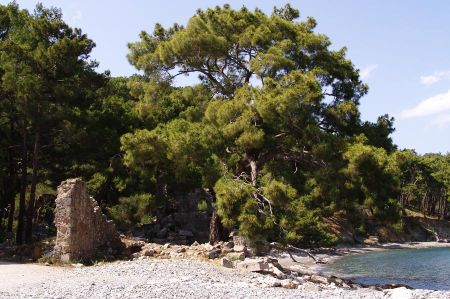 Theodektes, born around 400 BC, was a speechwriter and author of plays in Athens. In 353 BC he took part in an oratory competition at the funeral of Mausolus in Halicarnassus. In Athens he met the young Aristotle, who later became the teacher of Alexander the Great. When he came to Phaselis, Theodektes was already dead. Phaselis erected a statue of his famous citizen in the agora.
Theodektes, born around 400 BC, was a speechwriter and author of plays in Athens. In 353 BC he took part in an oratory competition at the funeral of Mausolus in Halicarnassus. In Athens he met the young Aristotle, who later became the teacher of Alexander the Great. When he came to Phaselis, Theodektes was already dead. Phaselis erected a statue of his famous citizen in the agora.
Coordinates: 36° 31′ N, 30° 33′ E
Please also read:
Olympos - Tree or wooden houses characterize the image
Antalya Museum - Archaeology and Ethnography
-
 Phaselis Antalya - Ancient Harbour
Phaselis Antalya - Ancient Harbour
Phaselis Antalya - Ancient Harbour
Phaselis Antalya - Ancient Harbour
-
 Phaselis Antalya - Ancient Harbour
Phaselis Antalya - Ancient Harbour
Phaselis Antalya - Ancient Harbour
Phaselis Antalya - Ancient Harbour
-
 Phaselis Antalya - Ancient Harbour
Phaselis Antalya - Ancient Harbour
Phaselis Antalya - Ancient Harbour
Phaselis Antalya - Ancient Harbour
-
 Phaselis Antalya - Ancient Harbour
Phaselis Antalya - Ancient Harbour
Phaselis Antalya - Ancient Harbour
Phaselis Antalya - Ancient Harbour
-
 Phaselis Antalya - Ancient Harbour
Phaselis Antalya - Ancient Harbour
Phaselis Antalya - Ancient Harbour
Phaselis Antalya - Ancient Harbour
-
 Phaselis Antalya - Ancient Harbour
Phaselis Antalya - Ancient Harbour
Phaselis Antalya - Ancient Harbour
Phaselis Antalya - Ancient Harbour
-
 Phaselis Antalya - Ancient Harbour
Phaselis Antalya - Ancient Harbour
Phaselis Antalya - Ancient Harbour
Phaselis Antalya - Ancient Harbour
-
 Phaselis Antalya - Ancient Harbour
Phaselis Antalya - Ancient Harbour
Phaselis Antalya - Ancient Harbour
Phaselis Antalya - Ancient Harbour
-
 Phaselis Antalya - Ancient Harbour
Phaselis Antalya - Ancient Harbour
Phaselis Antalya - Ancient Harbour
Phaselis Antalya - Ancient Harbour
https://www.alaturka.info/en/turkey-country/riviera/2276-phaselis-phaeselis-ancient-harbour-town#sigProId74a5a0c98e
